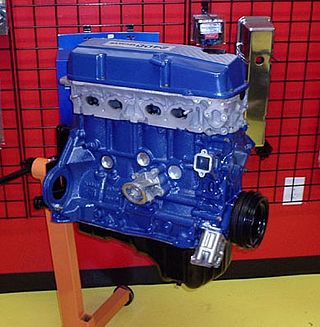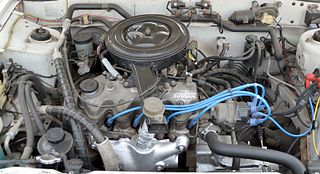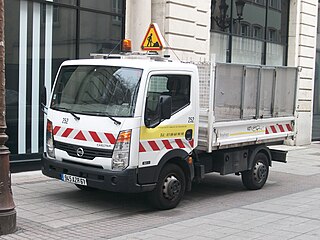Related Research Articles

The VK engine is a V8 piston engine from Nissan. It is an aluminum DOHC 4-valve design.

The KA engines were a series of four-stroke inline-four gasoline piston engines manufactured by Nissan, which were offered in 2.0 and 2.4 L. The engines blocks were made of cast-iron, while the cylinder heads were made of aluminum.

The Nissan Vanette is a cabover van and pickup truck produced by the Japanese automaker Nissan from 1978 until 2011. The first two generations were engineered by Nissan's Aichi Manufacturing Division for private, personal ownership, with the last two generations built by Mazda, rebadged as Nissans and refocused as commercial vehicles, based on the Mazda Bongo. The van has also been sold as the Nissan Sunny-Vanette or Nissan Van. The private purchase passenger platform was replaced by the Nissan Serena in 1991, renamed Vanette in various international markets, and came equipped with multiple engine and drivetrain configurations.

The Nissan A series of internal combustion gasoline engines have been used in Datsun, Nissan and Premier brand vehicles. Displacements of this four-stroke engine family ranged from 1.0-liter to 1.5-liter and have been produced from 1967 till 2009. It is a small-displacement four-cylinder straight engine. It uses a lightweight cast iron block and an aluminum cylinder head, with overhead valves actuated by pushrods.

The Nissan E series name was used on two types of automobile engines. The first was an OHV line used in the late 1950s and throughout the 1960s. The second was an OHC version ranging from 1.0 to 1.6 litres and was produced from 1981 till 1988. It was replaced by the GA engine series.
The Nissan H series of automobile engines is an evolution of the Nissan "R" engine which was based on the 1.5-liter, three-main bearing "G" engine used in the 1960s. Both inline-four and inline-six versions were produced. It is a pushrod OHV design with iron block, early models with an iron head, later models with aluminum head. Versions of this motor have been used in many Nissan autos and forklifts, well into the eighties and a version called H20II was in production until 2003. The SD diesels are based on this series of motors

The Nissan L series of automobile engines was produced from 1966 through 1986 in both inline-four and inline-six configurations ranging from 1.3 L to 2.8 L. It is a two-valves per cylinder SOHC non-crossflow engine, with an iron block and an aluminium head. It was the engine of the Datsun 510, Datsun 240Z sports car, and the Nissan Maxima. These engines are known for their reliability, durability, and parts interchangeability.

The Nissan Z engine is a series of automobile and light truck four-cylinder engines that was engineered by Nissan Machinery, manufactured by the Nissan Motor Company from 1979 through August 1989. All Z engines had 4 cylinders, a total of 8 valves and a single overhead camshaft (SOHC). Displacements ranged from 1.6 L to 2.4 L.The Z series' engine blocks were nearly identical to those of the earlier L Series with the exception of the Z24. While the Z16 and Z18 engines had a deck height similar to the earlier L13/L14/L16/L18 variants, the Z24 had a taller deck height to accommodate a longer stroke. The most notable difference between the Z-series engine and its predecessor was the introduction of a new crossflow cylinder head which reduced emissions by moving the intake ports to the right side of the engine opposite the exhaust ports. This change allows the exhaust port velocity to more effectively scavenge the cylinder and reduce reversion pulses to enhance induction. This change also limits maximum valve lift/lobe lift profiles rendering the cylinder head and valve train configuration undesirable for high-performance uses. The Z series evolved into the NA and KA engines which, along with the smaller CA series, replaced the Z series.

The Nissan J series are straight-4 and straight-6 gasoline internal combustion engines produced by Nissan from the 1960s through the 1980s. It is similar to the BMC B-Series engine that was built in Japan under licence as the Nissan 1H before being de-stroked to become the 1.0 L Nissan C and 1.2 L Nissan E engines, but wasn't a direct copy.

The HR is a family of straight-3 12-valve and straight-4 16-valve automobile engines with continuously variable valve timing, involving development by Nissan and/or Renault, and also Mercedes-Benz in the case of the H5Ht/M282. The designation of H engine is used by Renault, and M28x by Mercedes-Benz, to classify the family. There are three basic specifications of engine involving variations in engine architecture, or all-new architecture, with 72.2 mm (2.84 in), 75.5 mm (2.97 in) and 78 mm (3.07 in) bore diameter.

The MA is a straight-4 SOHC 0.9 L, 1.0 L, or 1.2 L engine first introduced in 1982 by Nissan, intended primarily for the K10 series Micra/March model. It shares design similarities with the older E engine, with an 8-valve hemispherical cylinder head but differs in that it uses an aluminium cylinder block. Unusually, the specified ignition timing for the MA10 running on the specified 90 RON gasoline was 2 degrees after top dead centre, reflecting a very high flame speed in the compact combustion chambers.
The SD engine was replaced by the Nissan TD engine. It was manufactured by Minsei Diesel Industries, Ltd., which was renamed Nissan Diesel Motor Co., Ltd in 1960.

The Nissan P engine is a large overhead valve, inline-six cylinder engine manufactured by Nissan Diesel Motor Co., Ltd. from 1959 to 2003 and used in light-duty trucks by Nissan, as well as in the Nissan Patrol. It replaced Nissan's older, sidevalve engines with which it shared its dimensions. This series of engines were based on the pre-war Type A engine, which was a license built Graham-Paige design.

Nissan Cabstar is the name used in Japan for two lines of pickup trucks and light commercial vehicles sold by Nissan and built by UD Nissan Diesel, a Volvo AB company and by Renault-Nissan Alliance for the European market. The name originated with the 1968 Datsun Cabstar, but this was gradually changed over to "Nissan" badging in the early 1980s. The lighter range replaced the earlier Cabstar and Homer, while the heavier Caball and Clipper were replaced by the 2-4 ton range Atlas (kana:日産・アトラス). The nameplate was first introduced in December 1981.The Cabstar is known also as the Nissan Cabstar, Renault Maxity and Samsung SV110 depending on the location. The range has been sold around the world. It shares its platform with the Nissan Caravan. In spring 2014, Cabstar is now known as NT400.
The Nissan TB straight-six petrol engine was released in 1987 as the TB42. Bore and stroke were 96 mm × 96 mm. Cubic capacity was 4,169 cc displacement). The engine was released with a two-barrel carburettor and a point type distributor. It was used in the Nissan Patrol Y60 and Y61 series.

The Nissan QD engine, successor to the Nissan TD engine, was an inline four-cylinder overhead valve diesel produced from the mid-1990s through 2000, with a turbocharger used on three variants, the QD32ETi(Elgrand and Terrano) QD32T and Qd32Ti(intercooled) in Chinese Markets. It was replaced by the Nissan ZD engine.

The Nissan Junior was a series of medium-sized pickup trucks built from 1956 until 1982. It was introduced to fill the gap between the smaller, Datsun Bluebird based Datsun Truck, and heavier load capacity Nissans under the Nissan Diesel brand, like the 80-series trucks. After the merger with Prince Motor Company, the Junior and the Prince Miler were combined, sharing most of the characteristics, with the Junior sold at Nissan Bluebird Store Japanese dealerships, and the Miler sold at Nissan Prince Store until 1970.

The Nissan Caball is a light commercial truck manufactured by Nissan Motors from December 1957 until December 1981. The Caball was mainly sold in Japan, Hong Kong, South East Asian countries, Australia, New Zealand, and few European countries and shared the Nissan Junior platform. While the Caball name came to an end in 1981 with the cancellation of the Junior, its larger replacement received the Nissan Atlas name in the domestic Japanese market. These are 2-4 ton trucks, the lighter versions in the Atlas truck range took over after the lesser Cabstar/Homer. In Japan, it was available at Nissan Store locations and replaced by the Nissan Atlas.
Tokyu Kurogane Industries, or Kurogane, was one of the first Japanese automakers. It built vehicles from about 1926 until 1962 when a subsidiary of Nissan, called Nissan Machinery, assumed operations as the company had become a member of the Nissan Group keiretsu. The word kurogane is an old term for iron, and one of the kanji used in Mr. Makita's first name. Remnants of the company were called Nissan Machinery until 1985, and operated as a separate entity within Nissan Techno until 2006, building and developing all of Nissan's current engines.

Nissan's sidevalve engines were based on the Austin 7 engine, with which they shared the 76 mm (2.99 in) stroke. The series began with a 495 cc iteration for the 1930 Datson Type 10 and ended with the 860 cc Type 10 engine which was built until 1964 for light commercial vehicles. Later versions were called the B-1, before being replaced in 1957 by the OHV Nissan C engine that was essentially a de-stroked version of another Austin design this time the BMC B-Series.
References
- 1 2 Bent, Alan. "1961 Datsun Cablight A120". Earlydatsun.com. Archived from the original on 2016-03-14.
- ↑ "東急くろがね・ニューマイティー" [Tokyu Kurogane New Mighty] (in Japanese). CyberAgent, Inc. 2015-04-01. Archived from the original on 2020-07-12.
- ↑ Ozeki, Kazuo (October 2010). カタログで知る国産三輪自動車の記録〔新装版〕[Catalog records of domestic three-wheeled vehicles] (in Japanese). Tokyo: MIKI Press. p. 100. ISBN 9784895225595.
- ↑ 自動車ガイドブック: Japanese motor vehicles guide book 1972—73 (in Japanese), vol. 19, Japan: Japan Automobile Manufacturers Association, 1972-10-23, p. 295
- ↑ Bent, Alan. "1968 Datsun Cabstar A320". Earlydatsun.com. Archived from the original on 2016-04-05.